| | Liocheles australasiae |  |
|
+6sowhon *~BEX~* pluto Bedlam Kuma LXDNG79 10 posters |
| Author | Message |
|---|
LXDNG79
Tityus

Number of posts : 605
Age : 45
Location : Borneo, Sarawak, Malaysia
Registration date : 2008-10-16
 |  Subject: Liocheles australasiae Subject: Liocheles australasiae  6/6/2009, 4:58 pm 6/6/2009, 4:58 pm | |
| Breeding and Raising Liocheles australasiae – the Dwarf Wood Scorpion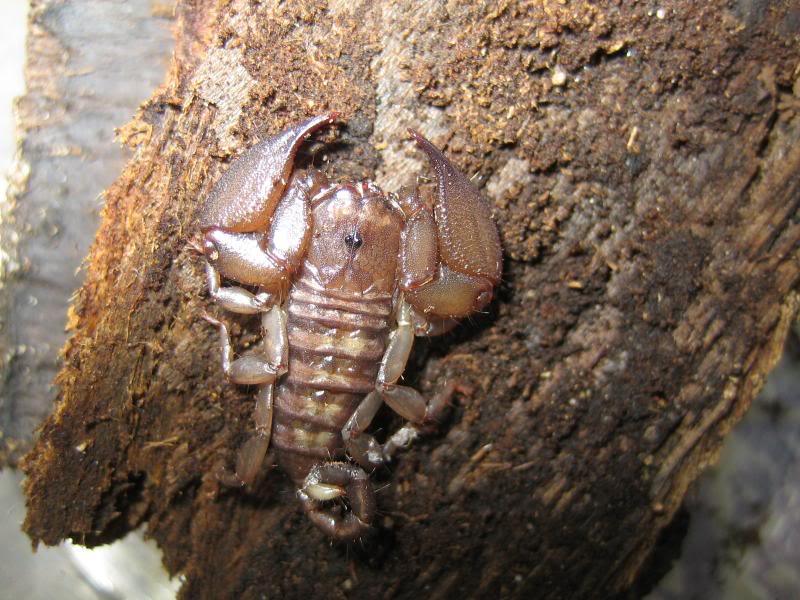 Another overdue post that has been ‘bugging’ me for awhile, no pun intended. I’m sure quite a few of you out there have occasionally come across some of these. They are virtually non-existent in the Malaysian pet trade since they are commonly encountered virtually anywhere in Malaysia, from suburban niches to primary rainforests. Like some scorpion species, these are parthenogenic and easy to breed as many of you may have experienced. 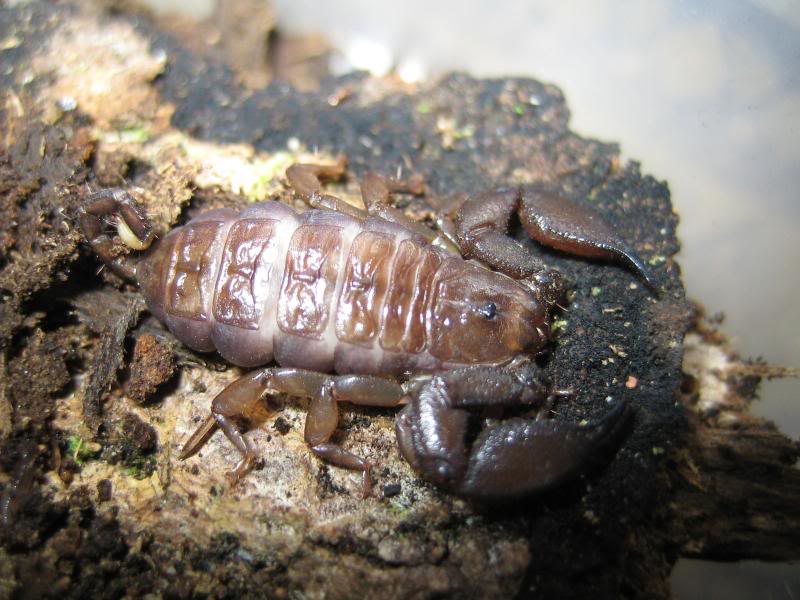 The one common dilemma commonly expressed is “how to feed scorplings of such small size?” especially when pinheads are not easily attainable. Other inquiries include the ideal captive conditions to encourage the development of embryos and consequentially partuition. This is based on my personal experience consisting mainly of trial and error experiments so I won’t pretend to be any kind of expert. Optimal breeding setupsMy first attempts were communal setups that emulated their natural habitat as best I could; narrow bark crevices in trees where I collected them in huge numbers. The barks were placed vertical as shown in earlier posts. 3 of the 6 adults I collected, gave birth not long after settling in but after 2 initial births, which yielded around 40 over slings in total, all reproduction ceased for an extended period of time; approximately 6 months. Additionally, incidents of cannibalism prompted me to try something different. 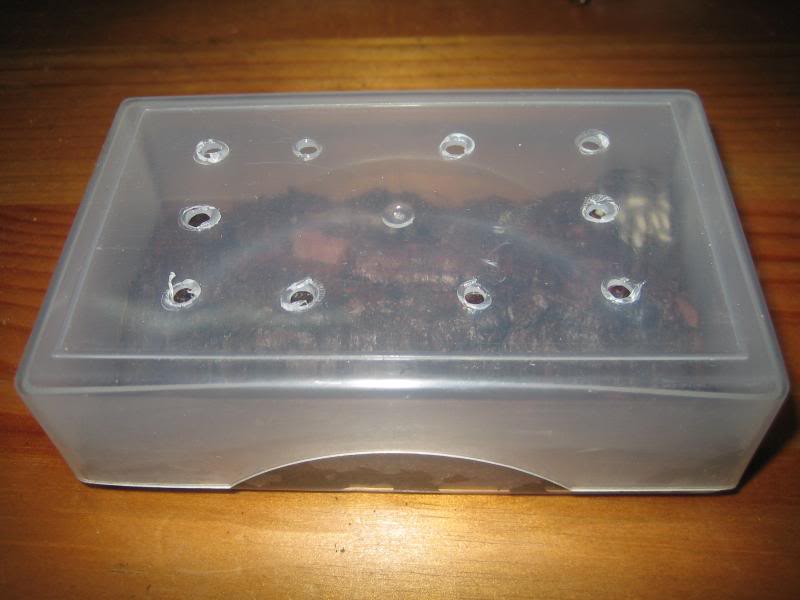 After trying cotton bud dispensers, which were more aesthetically driven than anything else, one of my adults popped in a temporary holding case fashioned from a business-card dispenser. This housing proved most conducive to prolific parthenogenesis. I think it has something to do with isolation as they seem more likely to breed in the absence of bothersome tankmates as their territorial natures would imply. It would seem that though often encountered living arboreally in vertical crevices, partuition seems to go better horizontally. The embryos are clearly visible underneath the tergites of this gravid individual. 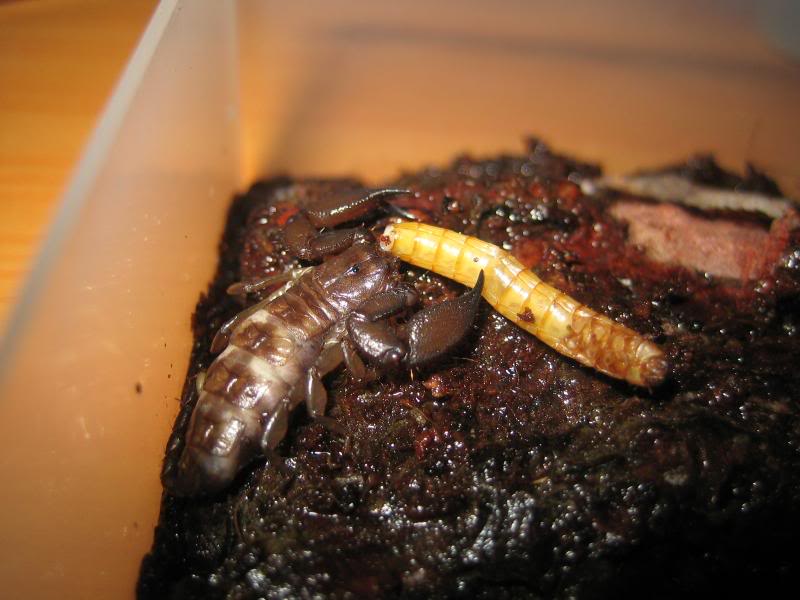 Once effectively isolated, gravid individuals are quick to birth. During this process, it is advisable to not disturb the mother by moving her enclosure, as they are quite sensitive and it may even halt the process mid way resulting in fewer offspring.  After realizing this one was birthing, I tucked her away and left her for a few days. 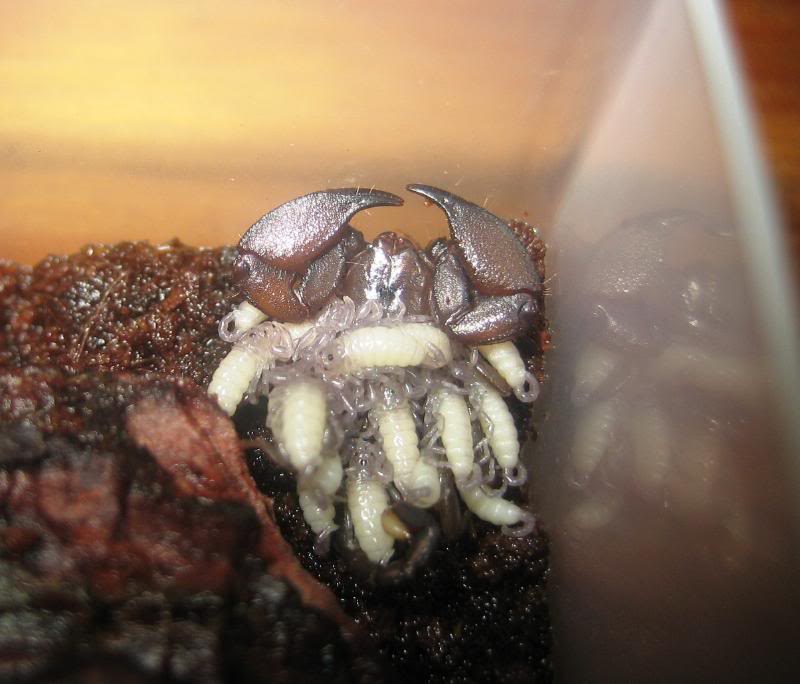 They may have broods of up to 40 babies at a time. Its ok to feed one mealworm at a time as the mothers will need to replenish the expended energy and thus will not feel compelled to consume her own young. 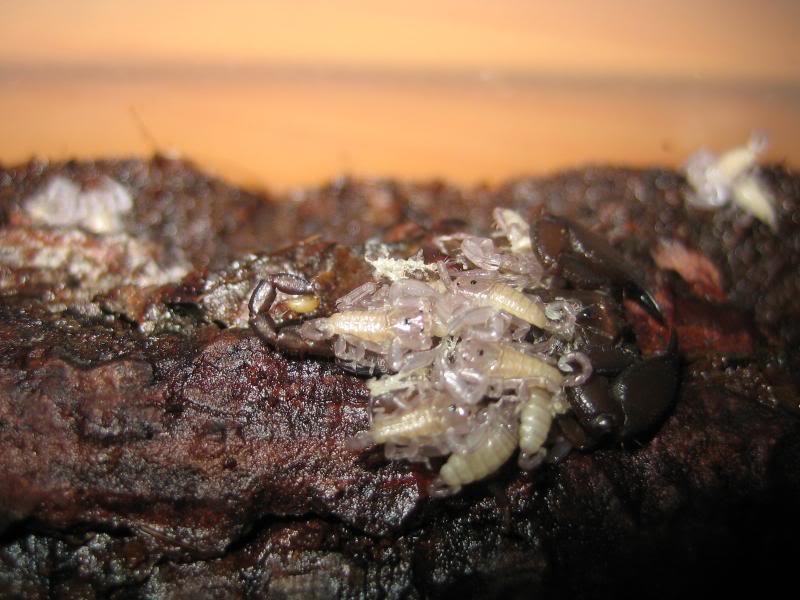 The young are quick to wean at 2i and stay nearby until as late as 4i or even 5i, so it is not necessary to move them any time soon. 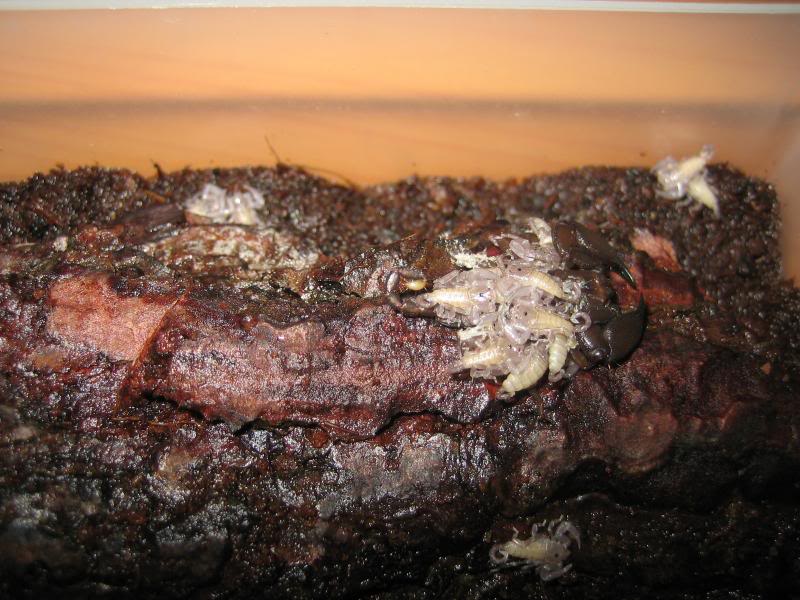 Young broods are cannibalistic until about 4i or 5i. Prior to this they may even work together to subdue larger prey like a small mealworm.  You may encourage the scorplings to take mealworms by chopping one up into small bits. Gently lift the bark piece under which they hide, sprinkle the mealworms bits on the ground where the bark should be and then place back the hide so that the scorplings on the bark’s underside meets with the mealworm bits on the coco-peat surface. 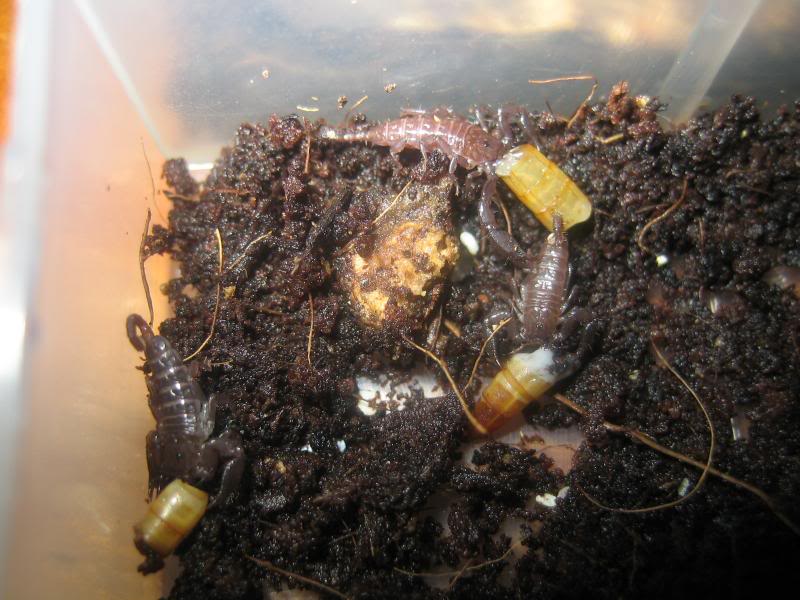 Don’t stress too much as they are unlikely to be crushed providing you replace the bark gently. They will no doubt taste the mealworms hemolymph stimulating them to feed. After a couple of times the scorplings will readily mob tossed-in mealies as the wriggle pass a line of tiny chela.  Raising scorplings Raising scorplings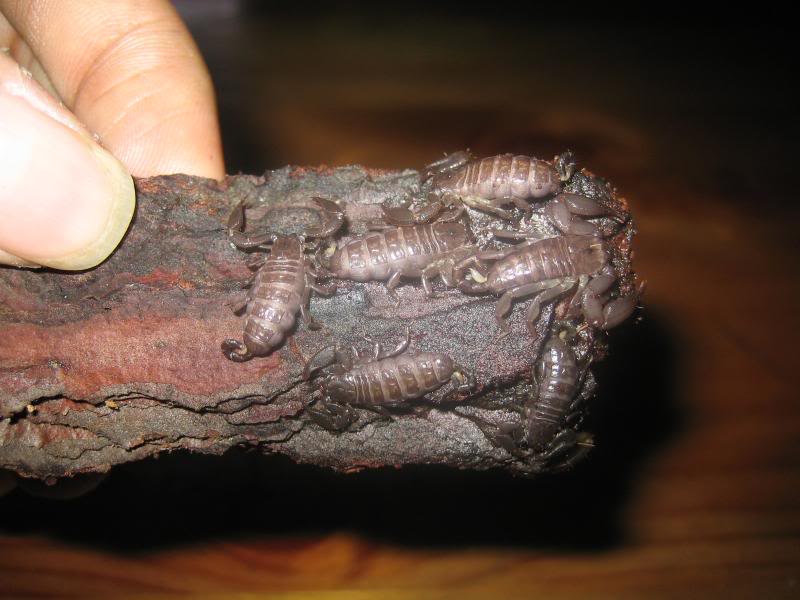 Though not particularly communal, scorplings are not inclined to cannibalism below 5i providing you give them enough food. 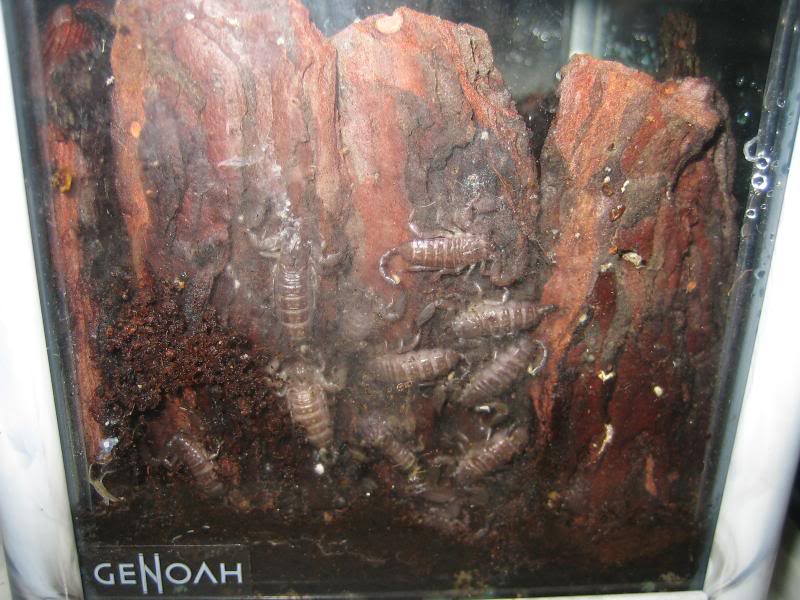 They will gladly clump together even with members that are not immediate siblings. Individual Housing At some point, in the interest of monitoring growth rates and minimizing the event of occasional cannibalism, Individual housing is eventually the most ideal option. Feeding them however may take more of your time. 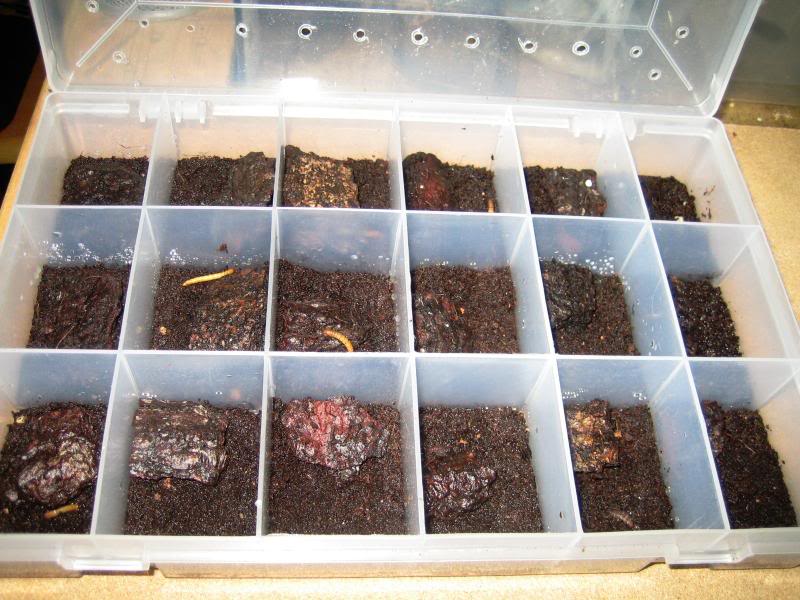 My sub-adults are raised in this multi-compartment storage case available at most hardware stores. I’m looking for one with taller walls and a clearer view.  Adults of breeding age are placed in these individual business card jewel boxes and stored in two mini-drawer compartments that I purchased for messing around with. Currently, my 1st batch of scorplings have reached adulthood and are pending transfer to their own apartments where we will see if they will produce the 1st gen of purely captive bred specimens. 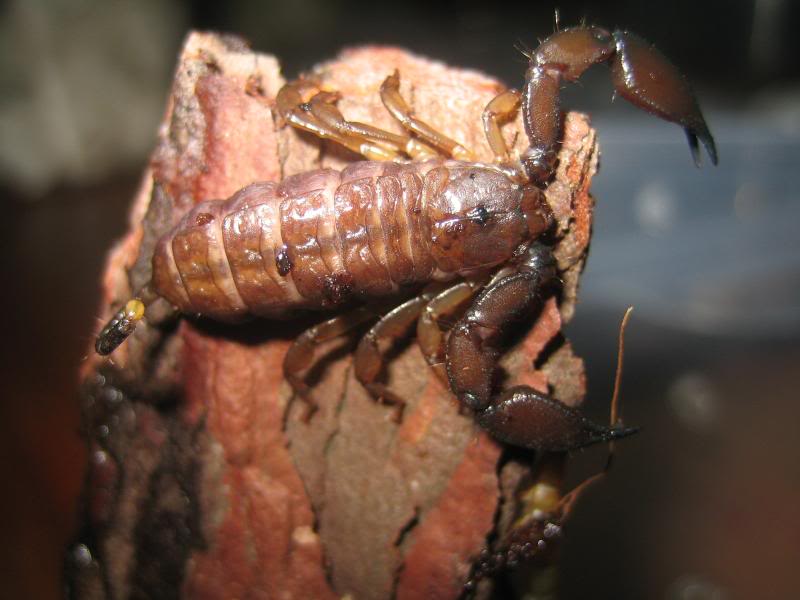 Phew, until next posts. Feel welcome to post comments and suggestions here, even pics of your own setups and colonies. I’m always eager to see someone else’s take on keeping these pocket-sized scorps. I’m considering having one on my office table in a small receptacle just to see if my colleagues will even notice it. 
Last edited by GS on 11/30/2011, 12:08 am; edited 1 time in total (Reason for editing : Updated title) | |
|
  | |
Kuma
Tityus

Number of posts : 839
Age : 46
Location : London
Registration date : 2008-09-29
 |  Subject: Re: Liocheles australasiae Subject: Re: Liocheles australasiae  5/21/2011, 4:26 am 5/21/2011, 4:26 am | |
| Mine resently gave birth to a load of scorplings  They have subsequently left mothers back now and are near impossible to find | |
|
  | |
Bedlam
Tityus

Number of posts : 548
Age : 30
Location : US
Registration date : 2011-04-03
 |  Subject: Re: Liocheles australasiae Subject: Re: Liocheles australasiae  5/22/2011, 8:24 am 5/22/2011, 8:24 am | |
| I've only read a few, but your post are always really interesting. Good work. | |
|
  | |
pluto
Leiurus
Number of posts : 2647
Age : 41
Location : Next to Manneke Pis
Registration date : 2011-04-16
 |  Subject: Re: Liocheles australasiae Subject: Re: Liocheles australasiae  5/22/2011, 8:41 am 5/22/2011, 8:41 am | |
| Quite rare roads you walk on :-)
How come pinheads are rarely available? WHy not breed your own?
Just a question... | |
|
  | |
LXDNG79
Tityus

Number of posts : 605
Age : 45
Location : Borneo, Sarawak, Malaysia
Registration date : 2008-10-16
 |  Subject: Re: Liocheles australasiae Subject: Re: Liocheles australasiae  5/22/2011, 12:43 pm 5/22/2011, 12:43 pm | |
| Pinheads are rarely available here cos the suppliers don't want to handle them being so fragile and I tried breeding my own from gravid crickets but they tend to succumb to predatory ants... | |
|
  | |
pluto
Leiurus
Number of posts : 2647
Age : 41
Location : Next to Manneke Pis
Registration date : 2011-04-16
 |  Subject: Re: Liocheles australasiae Subject: Re: Liocheles australasiae  5/22/2011, 1:22 pm 5/22/2011, 1:22 pm | |
| Damn wildlife must be interesting down there!
When you have a cricket container, ants get in it??? What species bother people over there as I can imagine they not only go for crickets but also for everything in the fridge, fruit on the counter, genitals.. | |
|
  | |
*~BEX~*
Administrator

Number of posts : 4246
Age : 41
Registration date : 2010-08-29
 |  Subject: Re: Liocheles australasiae Subject: Re: Liocheles australasiae  5/22/2011, 3:14 pm 5/22/2011, 3:14 pm | |
| Lol genitals  | |
|
  | |
pluto
Leiurus
Number of posts : 2647
Age : 41
Location : Next to Manneke Pis
Registration date : 2011-04-16
 |  Subject: Re: Liocheles australasiae Subject: Re: Liocheles australasiae  5/22/2011, 3:44 pm 5/22/2011, 3:44 pm | |
| Hehe well yes, if they got looking for food high up on furniture inside a plastic box, to get some pinheads out. I can imagine falling asleep and waking up with some bullet ants, in the pants Seriously though, ants are like pedes, not my cup of tea. Boogers are strong as hell. Good luck keeping them out of your house and away from those gorgeous scorplings!!! Love the picture of the scorplings on the bark with your thumb next to it. They're pretty big! btw Bex, dont worrie.. I don't live there.. you wil not have to share mine with the ants lol   | |
|
  | |
LXDNG79
Tityus

Number of posts : 605
Age : 45
Location : Borneo, Sarawak, Malaysia
Registration date : 2008-10-16
 |  Subject: Re: Liocheles australasiae Subject: Re: Liocheles australasiae  5/24/2011, 1:03 pm 5/24/2011, 1:03 pm | |
| Well just my invert space really since don't really apply insecticide in that area... But I've tried to get rid of them with some ant bait... it seems to work pretty well...
As for other things... you get your occasional American Cockroach which I will sometimes corner and feed off to my Heterometrus. Dragonflies which get trapped in the house sometimes make a nice meal for the tarantulas, and when winged termites begin flocking towards the porch light in their incalculable numbers, I sweep up as many as I can with a net as a substitute for pinheads to feed really small slings. I also bag the occasional house gecko for my male Temple Pit-Vipers...
Generally, wildlife is really something else down here in Borneo though it tends to be taken for granted by most locals. | |
|
  | |
sowhon
Centruroides
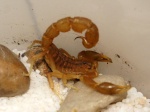
Number of posts : 194
Age : 42
Location : Malaysia
Registration date : 2010-11-02
 |  Subject: Re: Liocheles australasiae Subject: Re: Liocheles australasiae  6/27/2011, 9:32 pm 6/27/2011, 9:32 pm | |
| i find that the threads posted by bro LXGND79 is always so informative and interesting to read...now i have to hunt myself some Liocheles australasiae locally as i am really fascinated with this species now...  | |
|
  | |
LXDNG79
Tityus

Number of posts : 605
Age : 45
Location : Borneo, Sarawak, Malaysia
Registration date : 2008-10-16
 |  Subject: Re: Liocheles australasiae Subject: Re: Liocheles australasiae  6/28/2011, 1:35 pm 6/28/2011, 1:35 pm | |
| - sowhon wrote:
- i find that the threads posted by bro LXGND79 is always so informative and interesting to read...now i have to hunt myself some Liocheles australasiae locally as i am really fascinated with this species now...
 Thanks man, you're too kind... and going out to find them is really easy with a black light at night. Check out promising looking trees with bark that is shedding. You are likely to find them hiding in the narrow spaces under the bark and even more likely if there is presence of a viable food source i.e. ant or termite colonies. They're the most widespread scorpion species in lower-South-east Asia. You might even find them in trees near residential suburbs. Good hunting! Cheers and best regards | |
|
  | |
sowhon
Centruroides

Number of posts : 194
Age : 42
Location : Malaysia
Registration date : 2010-11-02
 |  Subject: Re: Liocheles australasiae Subject: Re: Liocheles australasiae  6/30/2011, 9:00 pm 6/30/2011, 9:00 pm | |
| - LXDNG79 wrote:
- Thanks man, you're too kind... and going out to find them is really easy with a black light at night. Check out promising looking trees with bark that is shedding. You are likely to find them hiding in the narrow spaces under the bark and even more likely if there is presence of a viable food source i.e. ant or termite colonies. They're the most widespread scorpion species in lower-South-east Asia. You might even find them in trees near residential suburbs. Good hunting!
Cheers and best regards i did try to look out for some LA during my hiking trip the other day but to no result....as i am in Penang, was told by fellow collector Ryo that i might have better luck looking for Lychas Scutilus.... will go for another round next month right after i get my blacklight on hand...  | |
|
  | |
gatlingpeas
Pandinus
Number of posts : 13
Age : 30
Location : INDONESIA
Registration date : 2010-09-18
 |  Subject: Re: Liocheles australasiae Subject: Re: Liocheles australasiae  8/8/2011, 11:29 am 8/8/2011, 11:29 am | |
| I want to ask, how can we tell the different between male and female Liocheles australasiae? | |
|
  | |
LXDNG79
Tityus

Number of posts : 605
Age : 45
Location : Borneo, Sarawak, Malaysia
Registration date : 2008-10-16
 |  Subject: Re: Liocheles australasiae Subject: Re: Liocheles australasiae  8/9/2011, 12:26 pm 8/9/2011, 12:26 pm | |
| - gatlingpeas wrote:
- I want to ask, how can we tell the different between male and female Liocheles australasiae?
This species is parthenogenic... all are females capable of self reproducing once they reach maturity Cheers & best regards | |
|
  | |
gatlingpeas
Pandinus
Number of posts : 13
Age : 30
Location : INDONESIA
Registration date : 2010-09-18
 |  Subject: Re: Liocheles australasiae Subject: Re: Liocheles australasiae  8/11/2011, 8:23 am 8/11/2011, 8:23 am | |
| - LXDNG79 wrote:
- gatlingpeas wrote:
- I want to ask, how can we tell the different between male and female Liocheles australasiae?
This species is parthenogenic... all are females capable of self reproducing once they reach maturity
Cheers & best regards OK. thanks. So if i find some, then they'll be able to reproduce by themselves, right? | |
|
  | |
**GS**
Leiurus

Number of posts : 2629
Age : 42
Location : facebook.com/ScorpionArchives
Registration date : 2010-09-06
 |  Subject: Re: Liocheles australasiae Subject: Re: Liocheles australasiae  8/12/2011, 12:00 am 8/12/2011, 12:00 am | |
| - gatlingpeas wrote:
- LXDNG79 wrote:
- gatlingpeas wrote:
- I want to ask, how can we tell the different between male and female Liocheles australasiae?
This species is parthenogenic... all are females capable of self reproducing once they reach maturity
Cheers & best regards
OK. thanks.
So if i find some, then they'll be able to reproduce by themselves, right? Dude.. didn't you just acknowledged what LXDNG79 has said about them being parthenogenic?  Good luck in your hunt! | |
|
  | |
LXDNG79
Tityus

Number of posts : 605
Age : 45
Location : Borneo, Sarawak, Malaysia
Registration date : 2008-10-16
 |  Subject: Re: Liocheles australasiae Subject: Re: Liocheles australasiae  8/12/2011, 9:22 am 8/12/2011, 9:22 am | |
| - gatlingpeas wrote:
- LXDNG79 wrote:
- gatlingpeas wrote:
- I want to ask, how can we tell the different between male and female Liocheles australasiae?
This species is parthenogenic... all are females capable of self reproducing once they reach maturity
Cheers & best regards
OK. thanks.
So if i find some, then they'll be able to reproduce by themselves, right? Yes... any single individual is capable of self-reproducing provided it is housed in the ideal conditions and given enough food. | |
|
  | |
tdark1
Centruroides

Number of posts : 129
Age : 42
Location : AZ
Registration date : 2011-07-25
 |  Subject: Re: Liocheles australasiae Subject: Re: Liocheles australasiae  8/12/2011, 12:55 pm 8/12/2011, 12:55 pm | |
| OP:
I really enjoyed reading your post, you detailed great information and thank you for the pictures! I wonder how often you will find these animals popping out babies for you, once you have an established colony?
Best Regards,
Rob
| |
|
  | |
sowhon
Centruroides

Number of posts : 194
Age : 42
Location : Malaysia
Registration date : 2010-11-02
 |  Subject: Re: Liocheles australasiae Subject: Re: Liocheles australasiae  8/15/2011, 9:18 pm 8/15/2011, 9:18 pm | |
| Gonna get my hands on a pair of LA soon....hope that my raising and breeding of these LA will be as successful as my AFS....  | |
|
  | |
Scorpeace
Babycurus

Number of posts : 380
Age : 31
Location : Bergen - Norway
Registration date : 2011-07-19
 |  Subject: Re: Liocheles australasiae Subject: Re: Liocheles australasiae  8/18/2011, 11:49 am 8/18/2011, 11:49 am | |
| And now i want Liocheles australasiae..!  Very good and informative post as always! Anyone able to send juvenile-subadult-adult Liocheles australasiae to Norway?  Pm me:) | |
|
  | |
Sponsored content
 |  Subject: Re: Liocheles australasiae Subject: Re: Liocheles australasiae  | |
| |
|
  | |
| | Liocheles australasiae |  |
|

